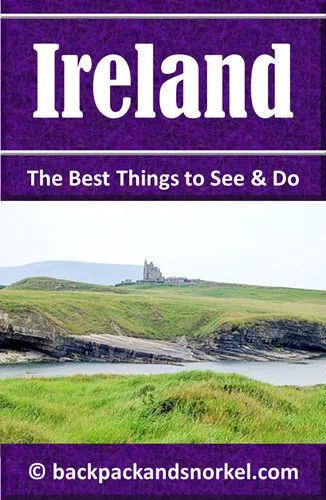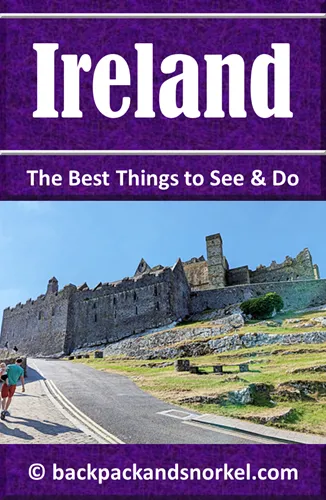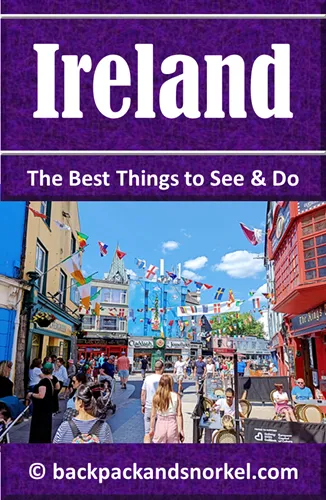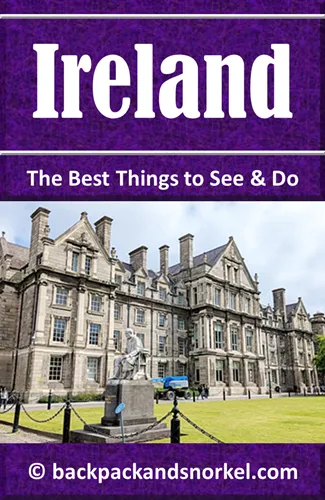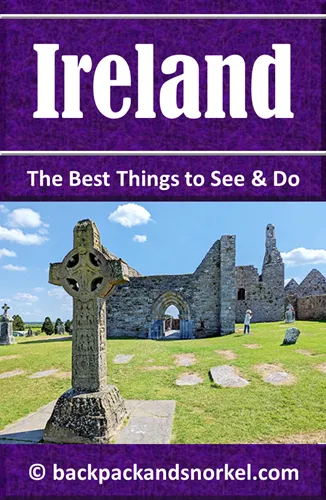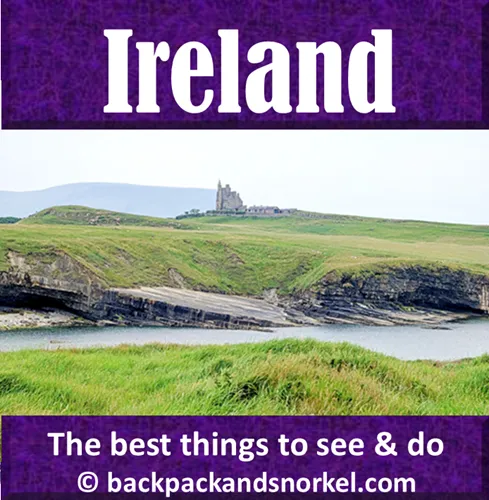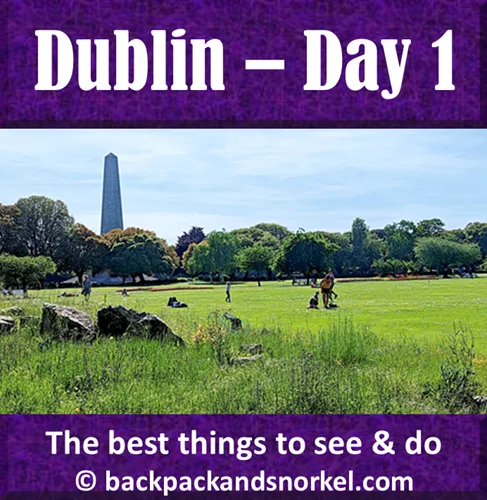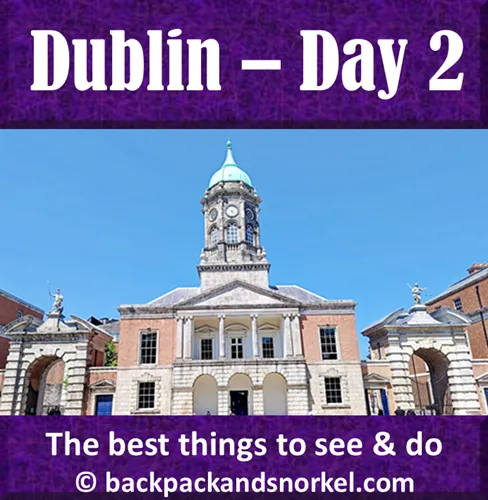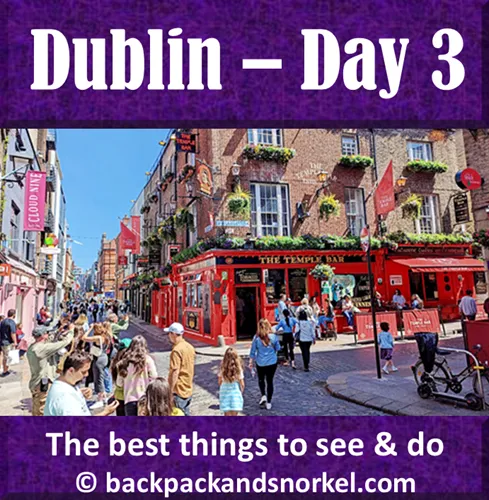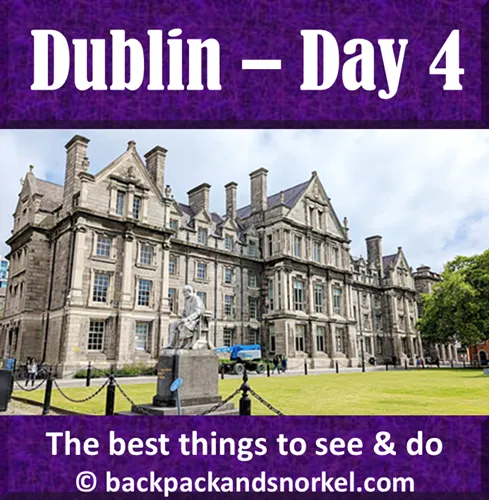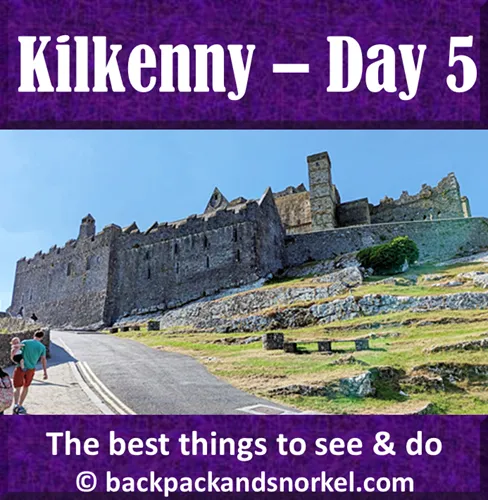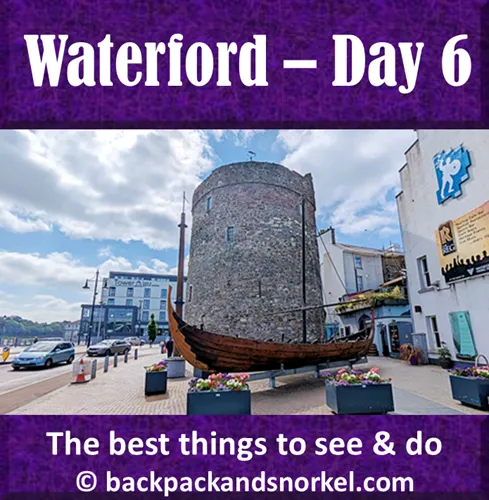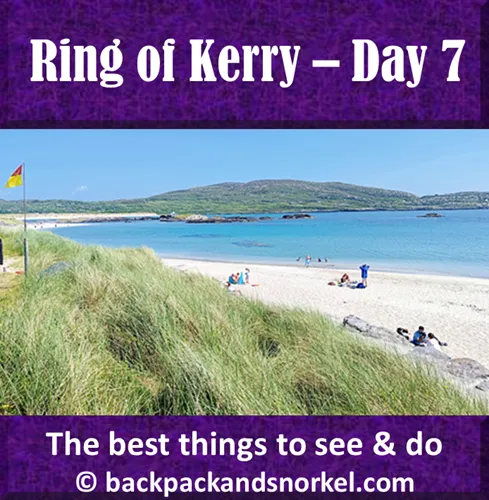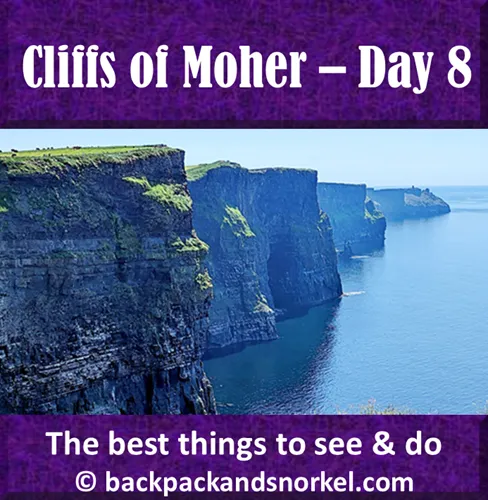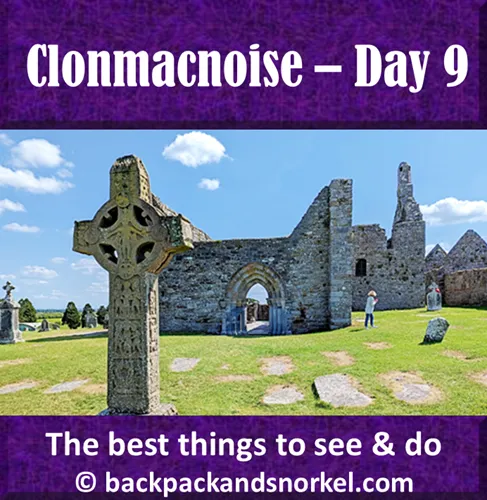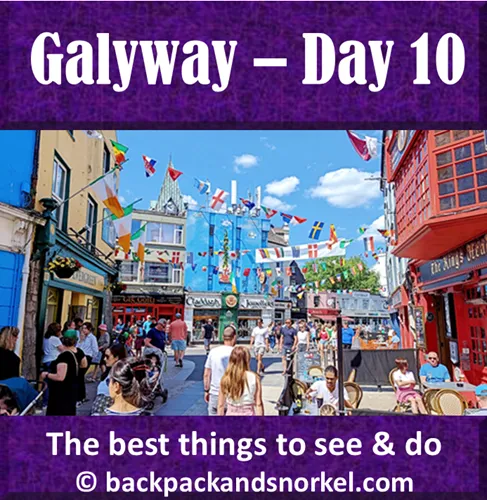Backpack and Snorkel Travel Guide for a Self-Guided Walking Tour of Dublin - Day 3 - Ireland Purple Travel Guide
Today we will explore more highlights of Dublin. We provide detailed information and the best things to see and we show lots of photos so you know what you can expect.
Today is your second full day in Dublin and it is a busy one, so get started early. Get on a bus and ride it to the busy bus stations on O’Connell Street, right north of downtown Dublin to begin your self-guided walking tour of Dublin.
O’Connell Street is the main access into downtown Dublin from the north. It is a busy street with beautiful old buildings and lots of restaurants, stores and it is good for people watching.

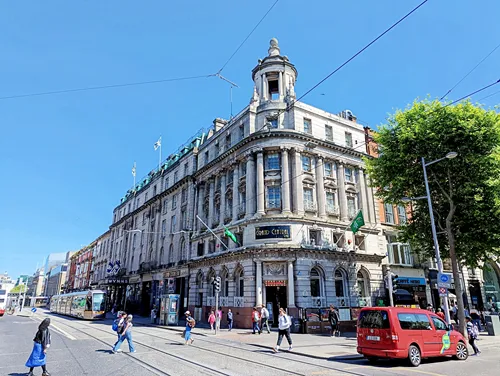
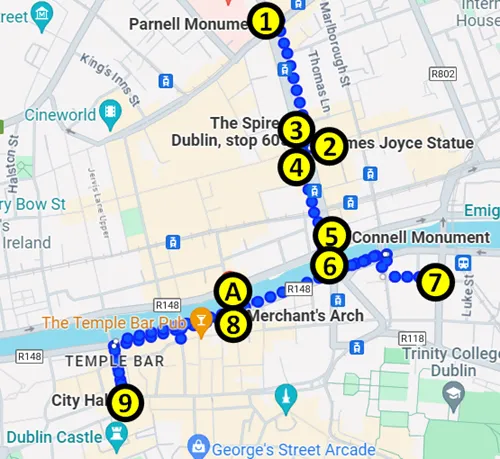
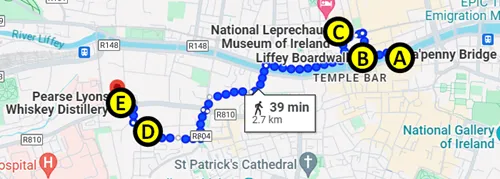
1 = Parnell Monument
2 = James Joyce Statue
3 = The Spire of Dublin
4 = General Post Office
5 = O'Connell Monument
6 = O'Connell Bridge
7 = Mulligan's
8 = Merchants Arch
9 = City Hall
A = Ha'penny Bridge
B = Liffey Boardwalk
C = National Leprechaun Museum of Ireland
D = Guinness Storehouse
E = Pearse Lyons Whiskey Distillery
Here at Backpack and Snorkel Travel Guides, we typically promote self-guided walking tours.
But we realize that not everybody likes to walk by themselves in a foreign city. So, just in case that you rather go with ab guide: NO PROBLEM! Please see the free GuruWalk and paid Viator tours below.
free GuruWalk tours
paid Viator tours
Parnell Monument
Built in 1907 at the intersection of Parnell Street and O'Connell Street, the monument commemorates Irish nationalist politician Charles Stewart Parnell (1846-1891), who:
- founded the Irish National Land League in 1879
- served as a Member of Parliament from 1875 – 1891
- was the leader of the Home Rule League from 1880 - 1882
- was imprisoned in Dublin’s Kilmainham Gaol in 1882, and was released after renouncing violent extra-Parliamentary action
- transformed the Home Rule League into the Irish Parliamentary Party, which he led from 1882 -1891
Parnell is known for his outstanding political leadership, but it is also tarnished by personal scandals of adultery and that he did not achieve his dream of obtaining Irish Home Rule.
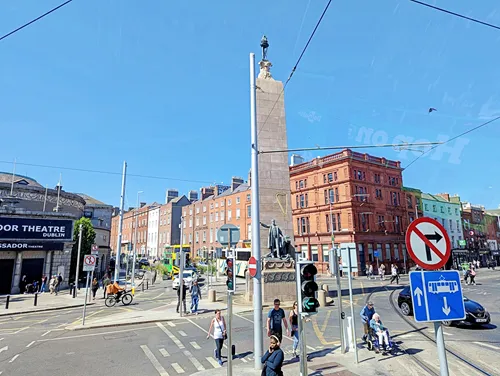
James Joyce Statue
In 1990, one of the most famous sculptures of Irish-American artist and actress Marjorie Fitzgibbon was unveiled on North Earl Street in Dublin: The James Joyce Statue, nicknamed: ‘The Prick with the Stick’.
It celebrates James Joyce (1882–1941), who was one of Ireland’s most famous novelists, poets, and literary critics and is widely considered one of the most influential and important writers of the 20th century.
Joyce is most famous for his novel Ulysses (1922). Other highly regarded works of his are the short-story collection Dubliners (1914), the novels A Portrait of the Artist as a Young Man (1916), and Finnegans Wake (1939).

The Spire of Dublin
The Spire of Dublin, also called The Monument of Light or The Spire of Light, is a 390 ft (120 m) tall, pin-like monument made from eight hollow stainless steel cone sections and weights 293,000 lbs (133 tons).
The longest cone section is 66 ft (20 m) tall. At the base, the diameter is 9.8 ft (3 m) and at the top 5.9 in (15 cm).
The lowest 33 ft (10 m) of the spire is patterned and the design is based on a core sample of rock formation taken from the ground where the spire stands and the DNA double helix. To apply the pattern, rubber stencil masks were applied and through them, the steel was textured by bead blasting.
The Spire was erected from 2002 – 2003 and cost €4 mio.
In 1998, a competition was held to select a monument for the site as part of a planned re-development of O'Connell Street. The Spire was chosen from a large number of submissions, but an appeal that made it all the way to the Irish High Court, delayed the construction until 2002.
Originally located at this place was Nelson's Pillar, which was bombed by the IRA in 1966, and had to be demolished. The site was vacant until 1988, when the Anna Livia monument was installed for the Dublin Millennium celebrations. In 2001, Anna Livia was removed, partially reworked and refurbished, and relocated to Croppies Memorial Park in 2011.

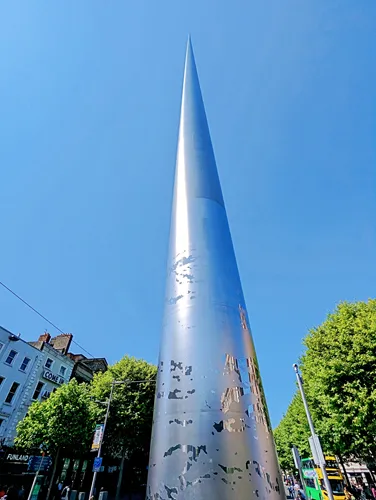
General Post Office
Built from 1814 – 1818, the General Post Office is the last great Georgian public building that was built in Dublin. Before 1818, the post office was located in various locations in Dublin.
The building is famous for being the headquarters of the leaders of the Easter Rising in 1916 against British rule in Ireland and it was here, that Patrick Pearse read out the Proclamation of the Irish Republic in 1916.
The impressive portico is 80 ft (24.4 m) wide and has six fluted Ionic columns which have a diameter of 54 in (137 cm). The portico is made of Portland stone, while the main building is made of mountain granite. The granite façade is the only part of the building that survived the devastating fire that broke out during the 1916 rebellion. It was until 1929 that the building was rebuilt.
The General Post Office is a working post office and a good place to buy stamps to send your Dublin postcards home.
Near the right-hand side of the main entrance is a gift shop where you can buy postcards.


O'Connell Monument
Built in 1882, this monument celebrates ‘The Liberator’ Daniel O'Connell (1775-1847), a distinguished political leader of Ireland's Roman Catholic majority and key architect of the Catholic emancipation in 1829, which enabled him to take a seat in the United Kingdom Parliament.

O'Connell Bridge
The original bridge that was built here from 1791 – 1794, was called the Carlisle Bridge. From 1877 – 1882, the bridge was widened to relieve traffic congestion from downtown Dublin to the north side across the River Liffey. Now the bridge is 164 ft (50 m) wide, while its length is only 147.6 ft (45 m).
For its reopening in 1882 and the unveiling of the O’Connell Monument north of it, the bridge was renamed O’Connell Bridge, in honor of ‘The Liberator’ Daniel O'Connell (1775-1847. O’Connell was a distinguished political leader of Ireland's Roman Catholic majority and key architect of the Catholic emancipation in 1829, which enabled him to take a seat in the United Kingdom Parliament.

Mulligan's
The original owners of Mulligan’s, the Mulligan family, had a license since 1782 and had moved the location of their pub several times, but settled on this location in 1854.
Mulligan’s is a pub that only serves drinks and no food in its three rooms. Among the many famous visitors are Judy Garland, and John F Kennedy.
The pub walls are decorated with posters, photographs, and showbills of the former Theatre Royal that was located near Mulligan's, and thus drew lots of their crew, staff, and visitors.
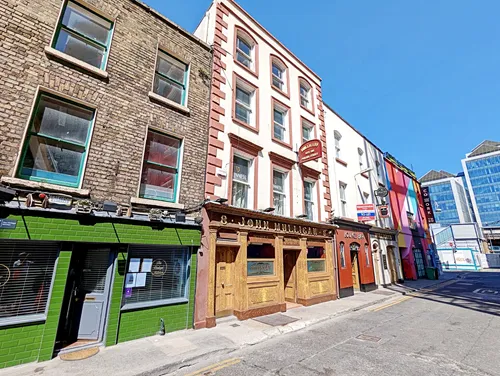
Merchants Arch
The Merchants Arch pub is located in Merchant’s Hall. Merchant’s Hall was built as a guild hall in 1821 and used as a Merchants' Guild until 1841, when the Municipal Reform Act dissolved the city guilds.
Near the entrance to the Merchants Arch bar is a vaulted archway, which is called Merchants’ Arch. It was built as an access point for people coming from the northside via the Ha'penny Bridge over the River Liffey to the Temple Bar area.

Dublin City Hall
Dublin’s City Hall is located on Dame Street right next to Dublin Castle. Dame Street got its name from the church of St. Mary del Dam, which originally sat at the site where the Dublin City Hall building stands.
In the 1600s, the church was torn down and replaced by the home of the Earl of Cork, which gave the hill it stands on the name Cork Hill.
In the 18th century, merchants in Dublin successfully lobbied the government to build a stock exchange on the site. Construction began in 1769, and the building was inaugurated as the Royal Exchange in 1779.
In 1850 or 1851, the building was purchased by the Dublin Corporation, and converted for the use of the city government as a town hall. In 1852, the building was officially renamed City Hall and the first Dublin City Council meeting was held here.
Dublin City Hall is a neoclassical building whose exterior is mostly made from white Portland stone which was quarried in Dorset. It has a central entrance hall (Rotunda) under a large dome which is supported by twelve 32 ft (9.8 m) tall columns.
The columns are surrounded by an ambulatory that was used by merchants for business discussions and meetings.
The Rotunda has a large floor mosaic which shows the city arms and motto ‘Obedientia civium urbis felicitas’ = ‘The obedience of the citizens makes us a happy city’.
Only the Rotunda is accessible to the public.
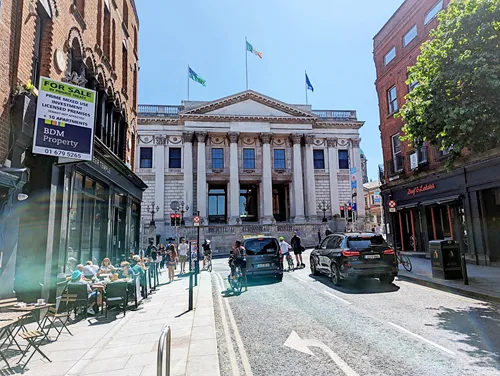
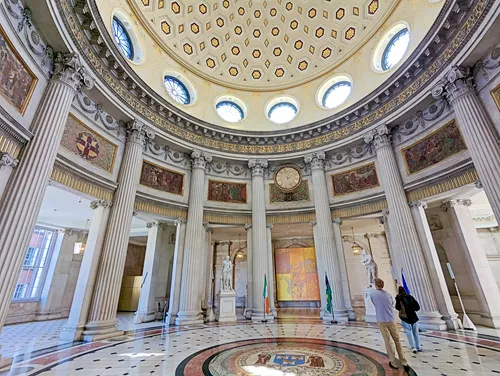

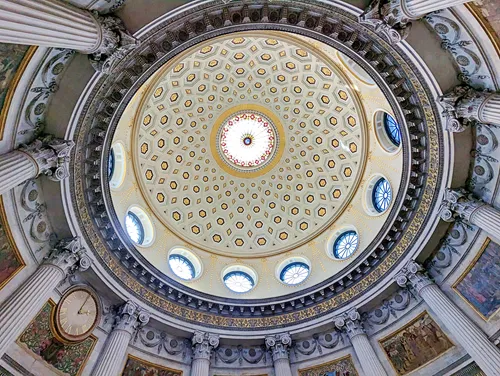
Ha'penny Bridge
Ha'penny Bridge is a pedestrian bridge over the River Liffey that was built of cast iron from Shropshire, England 1816. The bridge was shipped as 18 pieces to Dublin where it was then assembled.
The bridge was originally called the Wellington Bridge, but was changed to Liffey Bridge after the Irish War of Independence in 1922. While Liffey Bridge is still the official name, the bridge is most commonly called the Ha'penny Bridge.
Before the bridge was built, there were seven ferries that were used to shuttle people from one side of the River Liffey to the other. The ferries were in such a bad condition that their owner, William Walsh, was given a choice: either fix the ferries or build a bridge. Walsh chose to build a bridge and was allowed to charge a toll of a ha'penny (= halfpenny = 1/480 of a Pound = 1/24 of a Shilling = 1/2 of a Penny) from anyone crossing the bridge for the next 100 years. This was the same toll that he charged for the ferry rides.
Over time, the toll increased to penny-ha'penny (1.5 Pence) and some started calling the bridge the penny-ha'penny bridge. In 1919 the toll was abolished.
The bridge underwent extensive renovation to ensure its safety for the 27,000 people that were crossing it daily.
Unfortunately, people developed a bad habit that has led to extensive damage to many bridges worldwide and that is to apply love locks. In 2012 and 2013, lots of those locks were removed, in 2013 alone, 660 lbs (300 kg) were removed.
Signs were posted asking people to refrain from doing this.
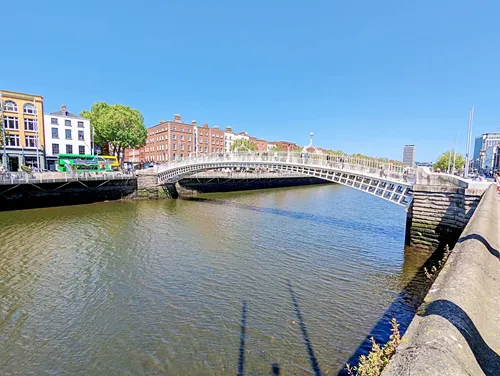

Liffey Boardwalk
Built in 2000 and extended in 2005, the Liffey Boardwalk is located on the northern side of the River Liffey. New boardwalks are currently being constructed.
The south-facing boardwalk with its wooden benches offers a great opportunity to relax from all the walking that you do in downtown Dublin and to soak up the sun, maybe eat something and watch people.
Sitting there, I found it interesting to see the many Guiness tanker trucks drive by or deliver their beer to pubs and stores north and south of the river.


National Leprechaun Museum of Ireland
Opened in 2010, the National Leprechaun Museum claims to be the first leprechaun museum in the world. The Irish Times has called it the Louvre of leprechauns. It is designed for adults and children 6 years and above.
If you are interested in exploring the world of Irish folklore and mythology, then this museum may be for you. You will join a guided tour where your guide will bring you to different rooms and tell you stories about the magic of mythical Ireland, the origins and meanings of leprechauns, and their representations in popular culture.
You will get to a tunnel filled with optical illusions, a wooden replica of Giant's Causeway (see our Northern Ireland Purple Travel Guide), and a room with gigantic furniture and utensils that will make you feel … like a leprechaun.
Day tours typically run daily every 30 min from 10:30am until the last tour at 5:30pm and admission is €18 per adult, at the time of writing.
DarkLand tours for adults only run Fridays and Saturdays every 30 min from 7pm until the last tour at 8:30pm and admission is €20 per adult, at the time of writing.
Guinness Storehouse
You can either take a 1.2 mile (1.9 km) or 30 min walk from the National Leprechaun Museum to the Guinness Storehouse, or take a bus.
To take the bus, walk across the River Liffey to bus stop 7891 ‘Wellington Quay’ and take bus G1 ‘Red Cow Luas’ or bus G2 ‘Liffey Valley SC’ for about 6 stations (19 min) and exit at stop 1941 ‘Steeven's Lane’. From there it is a 1,000 ft (350 m) walk to the Guinness Storehouse.
Alternatively, you can take the Red Line tram from the Jervis Luas stop for 6 stations and exit at the Fatima stop. From there, it is a 2,100 ft (650 m) walk to the Guinness Storehouse.
The Guinness Storehouse is a 7-story museum with interactive displays about the history of the company, information about the founder and the brewing process. On the 7th floor is the Gravity Bar which has great views of Dublin and where you can drink a pint of Guinness that is included in the admission price.
The museum was opened in 2000. It is located in a building that was built in 1902 as a fermentation plant and used for this purpose until 1988, when a newer fermentation plant was opened.
At the time of writing:
- the Guinness Storehouse is open daily from 10am to 5pm, on the weekends they open at 9:30am and either close at 5pm or 6pm.
- Tours are self-guided, but there are different tickets and experiences. The cheapest ticket is €20 per adult.
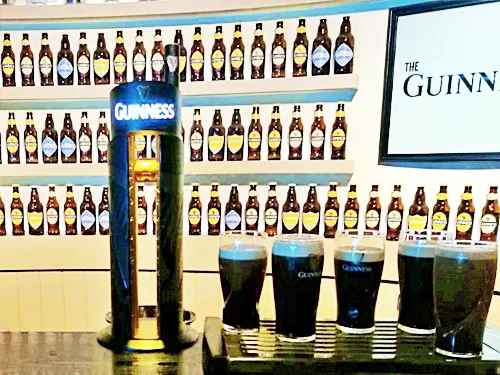

Pearse Lyons Whiskey Distillery
Pearse Lyons Whiskey Distillery is only a 1,300 ft (400 m) walk from Guinness Storehouse.
You can either tour this distillery or, if you are low on time, you can skip it and visit one of the other breweries we describe in this travel guide.
Thomas Pearse Lyons was an Irish scientist turned businessman, who founded US-based animal health and nutrition company Alltech Inc.
In 1999, Alltech founded the US-based Lexington Brewing and Distilling Company, which produces beers and spirits.
2012 was a monumental year for Lyons and Alltech:
- Alltech partnered with Ireland's Carlow Brewing Company and began distilling its first genuine Irish whiskey
- Alltech was named to a top-10 Best Companies Supporting the Arts in America by the Americans for the Arts nonprofit organization
- Lyons was named Businessperson of the Year by Business and Finance in Ireland
- Lyons received the Ireland-US Council's Award for Outstanding Achievement for strengthening economic ties between the United States and Ireland
In 2014, Lyons purchased St James' Church in Dublin and started converting it into a distillery. Pearse Lyons Distillery opened in 2017, about 6 months before Lyons’ death in 2018.
The church was established in 1707, but the building you see today was built in 1859.
Brewery tours also include a walk through the cemetery.
At the time of writing, guided tours take place daily between 10:30am and 6:30pm and include whiskey tasting, if you are 21 or older. Different tours are available and prices start at €20 per person.
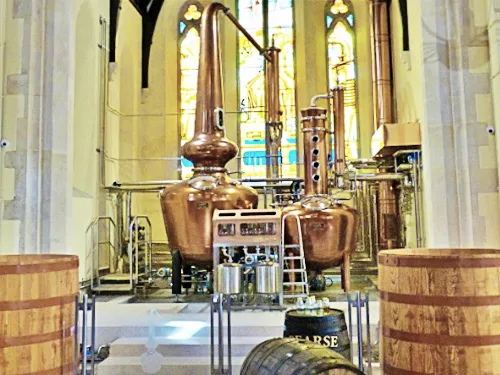
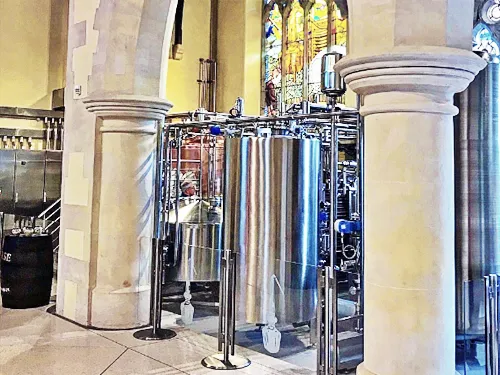
Where do you want to go now?
Author: Rudy at Backpack and Snorkel
Bio: Owner of Backpack and Snorkel Travel Guides. We create in-depth guides to help you plan unforgettable vacations around the world.
Other popular Purple Travel Guides you may be interested in:
Like this Backpack and Snorkel Purple Travel Guide? Pin these for later:
